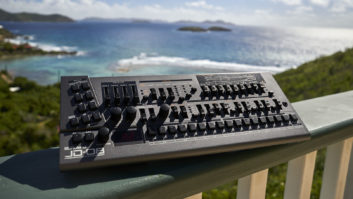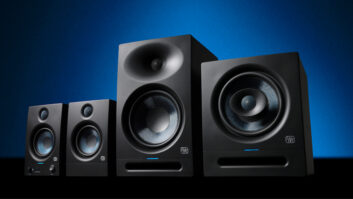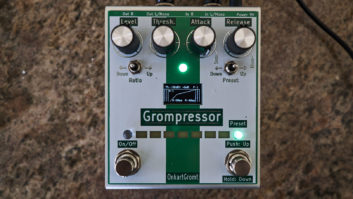
When PreSonus introduced the Eris XT Series of studio monitors last year, the company rolled out two models, the Eris E5 XT and the Eris E8 XT, which feature 5.25- and 8-inch woofers, respectively. Eris XT speakers depart from the original Eris models in the use of larger enclosures for enhanced bass response, and an Elliptical Boundary Modeled waveguide for the HF driver that produces a wider sweet spot with more controlled vertical dispersion (100 degrees horizontal by 60 degrees vertical). PreSonus expanded the Eris XT Series earlier this year with the addition of the E7 XT, which employs a 6.5-inch woofer and is the subject of this review.
The Eris E7 XT is intended for use in mid-to-large studio spaces. The 6.5-inch woofer is housed in a ported enclosure yielding a response rated down to 42 Hz, while the 1.25-inch, silk-dome, high-frequency driver is mounted on the EBM waveguide.
The E7 XT is Class AB bi-amplified, with a 70-watt amplifier for the LF driver and a 60-watt amp for the HF driver. Maximum SPL is said to be 104 dB, and though I didn’t challenge the E7 XT with such SPLs on a daily basis, they played more than loud enough for my purposes (mid-to-high 80s while tracking).
When powered, the PreSonus logo on the lower-right front panel illuminates; other than that, there are no front-panel controls. Rear-panel features include an IEC power receptacle with mains fuse, XLR, TRS and RCA input jacks (thank you), a power switch, and a series of controls for modifying the frequency response of the monitor.
Though its range is not indicated, the Gain control trims the volume from -∞ to about +4 dB, with a click stop at Unity. The High Frequency control applies a shelf EQ of ±6 dB at 10 kHz, while the Mid Frequency control is a peak EQ centered at 1 kHz with a range of ±6 dB. A Low Cutoff switch provides three choices: Off, 80 Hz or 100 Hz, the latter two at a slope of 12 dB/octave and therefore suitable for integrating E7 XTs with a subwoofer.
The remaining control on the E7 XT is a three-position switch called Acoustic Space, and it’s designed to help tune monitor response based on room placement. PreSonus recommends that the Acoustic Space is set to 0 when the monitor is placed mid-room, -2 for placement near one wall, and -4 if the monitor is placed in a corner.
Fire ‘Em Up!
I connected the E7 XTs to my Grace m905 monitor controller and set the speakers atop a pair of stands in the usual location in my control room, spaced approximately 4.5 feet apart, 18 inches from the front and side walls, and about 4 feet from the listening position.
I started with the Gain set to Unity, High and Mid Frequency controls at 0 dB, and the Acoustic Space switches set to 0 dB. Due to the coverage angle of the EBM waveguide, the E7 XT is intended to be deployed vertically (which is how I used them) and not horizontally. I normally use a subwoofer in my control room, but in the interest of evaluating the E7 XTs’ ability to handle low frequencies, the sub was defeated and I set the Low Cutoff switches to Flat.
Prior to making any adjustments to the E7 XT controls I listened to in-progress projects and finished mixes. I also made new mixes to get a feel for how those mixes made on the E7 XTs translate to the outside world.
These speakers produce a lot of detail without sounding “etched,” and they deliver a full low end that isn’t hyped. They’re capable of resolving different layers of dynamics, such as a quietly picked acoustic guitar, while at the same time producing a louder vocal up-front of the mix. I never felt like the E7 XTs were compressing my mixes, even at loud volumes. Some of the mixes I had already completed sounded a bit bright on the E7 XTs, and that characteristic was confirmed with the first batch of new mixes I did using them: when played on other systems, they sounded a bit dull, indicating that the E7 XTs lean toward the bright side in my control room.
I decided to tame the tweeter a bit, reducing the HF level control by an amount I believe to be around -3 dB (the adjustment pot was halfway between the 0 and -6 dB markings). I would prefer that the High and Mid Frequency controls had click stops, or at least one click stop in each direction halfway between 0 and ±6 dB, which would (a) ensure that the settings on each monitor could be more precisely matched, and (b) would allow repeatability of settings. My gripe notwithstanding, I found that this small tweak dialed in the high-frequency response nicely, and the subsequent mixes I made were pretty much spot-on. There were no surprises when I listened to the mixes on other playback systems. Levels and EQ were what I expected, as were more subtle elements such as the amount of compression on a lead vocal or the results of fader moves made in automation.
The E7 XTs can produce a lot of depth, and in most cases I heard that characteristic when I played my mixes on alternate systems. In one or two cases, ambient effects such as reverb and delay were a bit attenuated on the other playback systems as compared to the E7 XTs, resulting in mixes that sounded a bit drier than I expected. I’m okay with this because I’d prefer that my studio monitors reveal as much detail as possible, as opposed to covering it.

Tracking
In tracking sessions, the E7 XTs performed well, revealing a creaky chair when recording an acoustic guitar, or providing plenty of low-end mojo for playback of a slamming drum track. One notable attribute of the E7 XTs is that the low end is tight—I never felt like there was sloppy hangover from a kick drum hit or a slapped bass. Running a sine wave through the E7 XTs confirmed that they not only deliver usable bass response down to 40 Hz, but can actually reach down to 36 Hz.
Also, the E7 XTs didn’t deflate the low end of a mix when the volume was turned down, which is a problem for some speakers—their bottom end becomes anemic at low volumes. Low-mids were for the most part very natural-sounding, though there was one acoustic guitar session where the E7 XTs emphasized the resonance of the guitar body when the strings were plucked.
PreSonus’ claim that the Elliptical Boundary Modeled waveguide produces a wide sweet spot is well-founded. When seated almost directly in front of one E7 XT, I could still hear a stable stereo imag,e and I never had to move my head around in an effort to hear the high frequencies.
I didn’t make extensive use of the contour controls but did confirm that they work as intended. The effect of the Acoustic Space control is significantly different from that of the Low Cutoff switch. Measuring the effects of these switches using a Phonic PAA6 analyzer set to RTA revealed that the Low Cutoff introduces a traditional low-frequency rolloff, whereas the Acoustic Space switch produces a shelf in the response running from about 800 Hz down to the low limit of the monitor’s response. I briefly used the Eris E7 XTs in a setting where they were placed closer to the front wall, and the Acoustic Space setting did a good job of correcting the bass bump resulting from that placement.
PreSonus has really done a great job on the Eris E7 XT. I found that getting mixes to sound good on them was easy in terms of both instrumental balances and EQ, and more importantly, those mixes translated well to other listening environments. They may not blow your skirt up in a 500-square foot control room, but E7 XTs certainly play loud enough for a mid-sized control room.
Perhaps more importantly, they still sound good when you turn down the volume. The contour controls are effective, yet prevent a novice from completely screwing up the sound of the speakers, and the setup instructions found in the manual will be as useful to those who are setting up their first control room as they will be to more experienced users. All that and they’re very reasonably priced. Definitely recommended.
PRODUCT SUMMARY
Company: PreSonus
Product: Eris E7 XT
Website: www.presonus.com
Price: $324 each, MSRP
Pros: Good bang for the buck. Surprising LF extension. Easy learning curve. XLR, TRS and RCA input jacks.
Cons: Rear-panel trim settings for midrange and tweeter do not have detents. Response may be somewhat bright in certain rooms.







